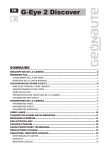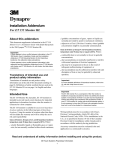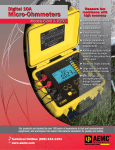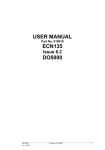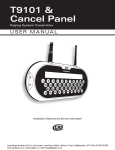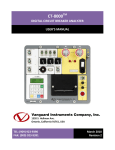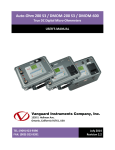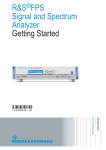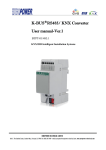Download MICRO-OHMMETER E N G L I S H User Manual
Transcript
n MICRO-OHMMETER ENGLISH User Manual 6292 Statement of Compliance Chauvin Arnoux®, Inc. d.b.a. AEMC® Instruments certifies that this instrument has been calibrated using standards and instruments traceable to international standards. We guarantee that at the time of shipping your instrument has met its published specifications. An N.I.S.T. traceable certificate may be requested at the time of purchase, or obtained by returning the instrument to our repair and calibration facility, for a nominal charge. The recommended calibration interval for this instrument is 12 months and begins on the date of receipt by the customer. For recalibration, please use our calibration services. Refer to our repair and calibration section at www.aemc.com. Serial #: _________________________________ Catalog #: 2129.83 Model #: 6292 Please fill in the appropriate date as indicated: Date Received: __________________________________ Date Calibration Due: ________________________ Chauvin Arnoux®, Inc. d.b.a AEMC® Instruments www.aemc.com Thank you for purchasing the AEMC Micro-Ohmmeter Model 6292. For best results from your instrument and for your safety, read the enclosed operating instructions carefully and comply with the precautions for use. These products must be only used by qualified and trained users. WARNING, risk of DANGER! The operator must refer to these instructions whenever this danger symbol appears. CAUTION! Risk of electric shock. The voltage at the parts marked with this symbol may be dangerous. CAUTION! HOT SURFACE! The metallic parts close to this symbol may cause burnrelated injuries. Application or withdrawal authorized on conductors carrying dangerous voltages. Type A current sensor as per IEC 61010-2-032. Must not be applied to or removed from conductors at dangerous voltages. Type B current sensor as per IEC 61010‑2‑032. Equipment is protected by double insulation. Battery Important instructions to read and to fully understand. Useful information or tip to read. The CE marking guarantees conformity with European directives and with regulations covering EMC. The trash can with a line through it means that in the European Union, the product must undergo selective disposal for the recycling of electric and electronic material, in compliance with Directive WEEE 2002/96/EC. Definition of Measurement Categories (CAT) CAT IV Measurement category IV corresponds to measurements taken at the source of low-voltage installations. Example: power feeders, counters and protection devices. CAT III Measurement category III corresponds to measurements on building installations. Example: distribution panel, circuit-breakers, machines or fixed industrial devices. CAT II Measurement category II corresponds to measurements taken on circuits directly connected to low-voltage installations. Example: power supply to domestic electrical appliances and portable tools. Micro-ohmmeter Model 6292 1 PRECAUTIONS FOR USE The protection obtained by the instrument can be compromised if it is used in a way that is not recommended by the manufacturer. ■■ Do not attempt to perform any tests with this instrument until you have read the user manual. ■■ Tests are to be carried out on de-energized circuits only! Never connect the unit to a live circuit. ■■ The micro-ohmmeter must be connected to the earth/ground point, through the ground terminal or the power cord. ■■ Be sure the power cord is accessible at all times, in case the instrument needs to be quickly unplugged for any reason. Always disconnect the power cord before performing any repair on the instrument. ■■ Do not obstruct either the intake vents or the fan, to avoid overheating. ■■ During a circuit breaker measurement its contacts must be closed and connected to an earth/ground point. The end connected to an earth/ground point must be connected to the “C-” terminal. ■■ Ensure the terminals are free of any voltage in relation to earth/ground point and between each other. Take into account that in a substation you will find, in disconnected points, high potential levels in relation to the earth/ground point. Those potentials are caused by presence of electromagnetic fields and can be minimized following the indications in the paragraph before. ■■ Make sure that the current connections are well connected, as well as the C clamp, to avoid undesirable heating. ■■ Be careful when manipulating the current terminals in the instrument. High temperatures may occur in the current connections. ■■ Never connect or disconnect the cables during a measurement. If a modification must be made, press the STOP button first. ■■ The micro-ohmmeter should never be used in an explosive environment (this includes poorly ventilated battery rooms and enclosures). ■■ The instrument, test leads and measuring wires must be free of defects and should be changed if there is any evidence of deterioration (insulation split, burnt, etc.). ■■ Never exceed the safety values indicated in the specifications. 2 Micro-ohmmeter Model 6292 Table of Contents 1. INTRODUCTION..............................................................................................5 1.1 Receiving Your Shipment......................................................................5 1.2 Ordering Information..............................................................................5 1.2.1 Accessories...............................................................................5 1.2.2 Replacement Parts....................................................................5 2. PRODUCT FEATURES......................................................................................6 2.1 Description.............................................................................................6 2.2 Features................................................................................................6 2.3 Applications...........................................................................................7 2.4 Control Features....................................................................................8 2.5 Current Probe Connector......................................................................8 2.6 LCD Display...........................................................................................9 2.7 Keypad and Function Buttons...............................................................9 2.8 Rotary Knob.........................................................................................10 3. INSTRUMENT CONFIGURATION.....................................................................11 3.1 Time and Date Settings.......................................................................13 3.2 Display Options...................................................................................14 3.3 Cooling System...................................................................................15 3.4 Language.............................................................................................15 4. OPERATION..................................................................................................16 4.1 Getting Started....................................................................................16 4.2 Test Leads...........................................................................................17 4.3 Main Screen........................................................................................17 4.4 Changing the Operating Mode............................................................17 4.5 Creating a New Object Name..............................................................18 4.6 Adjusting the Test Current....................................................................18 4.7 Adjusting the Test Duration..................................................................19 4.8 Measurement Filtering and Working Frequency..................................20 4.9 Running a Test.....................................................................................20 4.9.1 Normal Mode...........................................................................20 4.9.2 Both Sides Grounded (BSG) Mode.........................................21 Micro-ohmmeter Model 6292 3 4.9.3 Making Current Adjustments...................................................21 4.10 Warning Messages............................................................................22 4.10.1 Saving a Test.........................................................................22 4.11 Storing Objects in Memory.................................................................23 4.11.1 Viewing Stored Results..........................................................23 4.11.2 Navigating through an Object................................................24 4.12 Checking Memory Usage..................................................................25 4.13 Removing Tests and Objects from Memory.......................................26 4.13.1 Erasing a Single Test.............................................................26 4.13.2 Erasing an Object..................................................................27 4.13.3 Erasing the Entire Memory....................................................27 4.13.4 Memory Compaction.............................................................28 5. DATAVIEW® SOFTWARE................................................................................29 5.1 Installing DataView..............................................................................29 5.2 Connecting the Instrument to your Computer......................................33 5.3 Establishing Communication to the Instrument...................................33 5.4 The Micro-Ohmmeter Control Panel....................................................34 5.5 Configuring the Instrument..................................................................35 5.6 Downloading Stored Tests...................................................................37 6. SPECIFICATIONS..........................................................................................39 7. MAINTENANCE.............................................................................................40 7.1 Warning...............................................................................................40 7.2 Cleaning..............................................................................................40 7.3 Fuse Replacement..............................................................................40 7.4 Repair and Calibration.........................................................................41 7.5 Technical and Sales Assistance...........................................................41 7.6 Limited Warranty..................................................................................42 7.7 Warranty Repairs.................................................................................42 4 Micro-ohmmeter Model 6292 1. INTRODUCTION 1.1 Receiving Your Shipment Upon receiving your shipment, make sure that the contents are consistent with the packing list. Notify your distributor of any missing items. If the equipment appears to be damaged, file a claim immediately with the carrier and notify your distributor at once, giving a detailed description of any damage. Save the damaged packing container to substantiate your claim. 1.2 Ordering Information Micro-ohmmeter Model 6292 (200A, DataView® Software)............Cat. #2129.83 Includes meter and an accessory case supplied with a set of 20 ft Kelvin test leads w/C-clamp, ground lead (green) with clamp, 5 ft USB cable, 110V US power cord, 15A fuse (5x20mm), quick start guide and a USB stick supplied with a user manual and DataView® software. 1.2.1 Accessories Current Probe Model MR6292..........................................................Cat. #2129.86 Set of Two, 50 ft Color-coded Kelvin Leads w/C-clamp ...................Cat. #2129.87 1.2.2 Replacement Parts Ground Lead (green) w/clamp...........................................................Cat. #2129.88 Set of Two, 20 ft Kelvin Test Leads w/C-clamp.................................Cat. #2129.89 Set of 5, Fuse 15A 250V, 5x20mm (Slow-Blow)................................Cat. #2130.00 USB Cable (5 ft)................................................................................Cat. #2140.46 Power Cord.......................................................................................Cat. #5000.40 Order Accessories and Replacement Parts Directly Online Check our Storefront at www.aemc.com for availability Micro-ohmmeter Model 6292 5 2. PRODUCT FEATURES 2.1 Description The AEMC® Model 6292 is a portable high-current micro-ohmmeter that incorporates optimized filters and protection for measurements in electrical substations. The Model 6292 can be used to accurately measure very low contact resistances on high voltage circuit-breakers and switches, busbars, etc., with test currents up to 200A. It employs the four-terminal method Kelvin principle to eliminate errors caused by test leads and their contact resistances. Measurement accuracy is guaranteed through a state-of-the-art signal amplification system, offset-free with high long-term stability. Resistance readings are shown in the alphanumeric display with up to 4½ digit resolution. It allows measurement of resistances up to 1Ω with resolution as low as 0.1µΩ. Test currents can be adjusted by the operator and are displayed on the digital display. The Model 6292 has an internal memory for storing up to 8000 readings. These stored readings can be downloaded to a computer through a USB interface. The advanced high current generation system significantly decreases both weight (24 lbs [11 kg]), and size. The hard plastic case is highly resistant to impact and environmental conditions. Internal thermal sensors in all sensitive components prevent overheating damage to the instrument. This rugged but light-weight instrument can easily be carried by one person. 2.2 Features ■■ Cooling system increases the number of sequential tests that can be performed ■■ Programmable and manual test current selection from 5 to 200A ■■ Accurately measures low contact resistances with test currents up to 200A ■■ Measures resistances from 0.1µW to 1W ■■ Low resolution of 0.1µW ■■ Perform tests normally or with both sides of the switch gear connected to the ground ■■ Display is available in four languages (English, French, Spanish and Italian) ■■ Can measure objects with both sides grounded 6 Micro-ohmmeter Model 6292 ■■ Programmable test duration from 5 to 120 seconds, with unlimited duration tests at currents 100A and below. ■■ Direct viewing of stored tests on the large LCD digital display ■■ Stores up to 8000 test results ■■ USB communication interface ■■ Direct printout using DataView® software and a PC ■■ Configurable from a PC using DataView ■■ Rugged, light-weight and water-resistant case ■■ Protected by double insulation terminals, and USB isolated from the power supply 2.3 Applications ■■ Test switchgear contact resistance ■■ Test circuit breaker contact resistance ■■ Test air frame bonding ■■ Test rail bonding ■■ Test pipeline bonding Micro-ohmmeter Model 6292 7 2.4 Control Features 8 9 1 10 2 11 3 4 12 5 13 14 6 7 15 Figure 2-1 1. 2. 3. 4. 5. 6. 7. 8. Intake vents Current output terminal (C+) Potential terminal (P+) Potential terminal (P-) Current output terminal (C-) Ground terminal Current probe connector LCD Display 9. Fuse 10. Power cord connector 11.Fan 12. Alphanumeric keypad and function buttons 13. Rotary test knob 14. USB communication port 15. ON/OFF switch 2.5 Current Probe Connector 1. Positive supply for the current probe (+9VDC) 1 5 2. Negative supply for the current probe (Gnd) 3. Not connected 2 3 4 4. Current probe output signal (+) 5. Current probe output signal (-) Figure 2-2 NOTE: The positive supply can supply 80mA maximum. 8 Micro-ohmmeter Model 6292 2.6 LCD Display The four line x 20-digit alphanumeric LCD display provides the following information: ■■ Measurement result and corresponding measuring unit ■■ Elapsed time since the measurement started ■■ Test current ■■ Messages to the operator The display also features an adjustable backlight. 2.7 Keypad and Function Buttons The Model 6292 can be operated and configured using the alphanumeric keypad. The keypad enables you to name objects (groups of tests) and enter date/time information, and the function buttons let you select a number of configuration settings. The function buttons perform as follows: ■■ CAPS LOCK: When enabled (indicated by a green LED just above it) results in all typed letters appearing capitalized on the display. When deselected, letters appear in lower case. ■■ NUM LOCK: When enabled causes the keypad to print numbers rather than letters. When NUM LOCK is disabled, the keypad prints letters. ■■ MENU: Displays the main menu, from which you can configure test and instrument settings. ■■ DEL: Erases characters. ■■ SAVE: Saves the configuration or advances one menu level. ■■ ESC: Aborts some functions or returns back one menu level. ■■ MODE: Selects between Normal or BSG (both sides grounded) operation modes. ■■ START: Starts a test. ■■ STOP: Stops a test. Micro-ohmmeter Model 6292 9 2.8 Rotary Knob PRESS TO ENTER The rotary knob has two primary purposes: 1. Adjusts the current during a test 2. Navigates through menus and select options. ■■ When the main screen is displayed, a short press will perform the MENU button function. SELECT / CURRENT ADJUST Figure 2-3 ■■ When in a menu, rotating the knob navigates through listed options; a short press selects the highlighted option. ■■ When in a menu, pressing the rotary knob for two seconds performs an ESC button function. ■■ During a fixed current test, a short press will allow manual adjustment of the test current. 10 Micro-ohmmeter Model 6292 3. INSTRUMENT CONFIGURATION The Model 6292 can be configured by performing the following: ■■ Press the MENU button to display the main menu. ■■ Turn the rotary knob clockwise (to move up) or counter-clockwise (to move down) to navigate through the listed options. When the desired option is highlighted, select it by giving the rotary knob a short press. ■■ Press the rotary knob or the SAVE button to save a setting. ■■ Press and hold the rotary knob to return to the previous menu. NOTE: At any point during navigation, pressing the MENU button will return directly to the main menu. The following parameters are configurable: MAIN SCREEN: ■■ Setup Test ■■ Edit Object Name ■■ Test Current ■■ Test Duration ■■ Return LANGUAGE: ■■ English ■■ Français ■■ Italiano ■■ Español MEMORY: ■■ Recall ■■ Clear All ■■ Usage ■■ Return SETTINGS: ■■ Date Format ■■ MM/DD/YY ■■ DD/MM/YY Micro-ohmmeter Model 6292 11 ■■ Time Format ■■ 12H ■■ 24H ■■ Set Date ■■ Set Time ■■ Auto Save ■■ OFF ■■ ON ■■ Fan ■■ AUTO ■■ ON ■■ Display ■■ Backlight ■■ Contrast ■■ Return ■■ System Info ■■ Return NOTE: The instrument can also be configured from the Micro-ohmmeter Control Panel (see §5.5) within DataView®. 12 Micro-ohmmeter Model 6292 3.1 Time and Date Settings A good way to become familiar with the Model 6292 menu options and navigation features is to enter time and date settings. For example, you can choose either MM/DD/YY or DD/MM/YY format for dates. To set this option, press the MENU button to display the main menu: === MENU === ÎÎSETUP TEST LANGUAGE MEMORY Turn the rotary knob counter-clockwise until the arrow scrolls down to the Settings option. (Due to limited space, only three options at a time can be displayed. Scrolling displays additional menu options.) === MENU === LANGUAGE MEMORY ÎÎSETTINGS With Settings selected, press the rotary knob to display the Settings menu. === SETTINGS === ÎÎDATE FORMAT TIME FORMAT SET DATE Select Date Format, and choose either MM/DD/YY or DD/MM/YY. === DATE FORMAT === • MM/DD/YY DD/MM/YY After you make your selection by pressing the rotary knob, press the ESC button to return to the Settings menu. You can now choose the time display format (12 or 24 hour) by using the rotary knob to select the Time Format option. === TIME FORMAT === • 12H 24H Micro-ohmmeter Model 6292 13 Now that you have defined the time and date display formats, you can now enter the actual time and date. To do this, return to the Settings menu and select Set Date: SET DATE 10/16/2013 Use the number keypad to enter the current date. If you make a mistake, you can press ESC to return to the Settings menu without changing the current settings. If you enter an invalid number, such as “20” in the MM field, the system defaults to the highest allowable value (in this case 12). To enter the system time, select Set Time from the Settings menu: SET TIME 02:36 PM As with the date, use the number keypad to enter the current time. If you are using 12 hour time format, turn the rotary knob to toggle between AM and PM. 3.2 Display Options The Settings menu lets you adjust your display’s backlight and contrast levels to suit the illumination level in the environment in which the Model 6292 is being used. To do this, select Display from the Settings menu. The Display menu appears: === DISPLAY === ÎÎBACKLIGHT CONTRAST RETURN Selecting either Backlight or Contrast displays a bar graph that represents the current setting. Use the rotary knob to raise or lower the level as appropriate. When you are finished with the Display menu, you can select Return or press the ESC button to return to the Settings menu. 14 Micro-ohmmeter Model 6292 3.3 Cooling System The Model 6292 features a cooling system that increases the number of sequential tests that you can run without overheating the instrument. A fan in the front panel exchanges internal heated air with ambient air. The cooling system includes a filter for preventing dust and dirt from entering the instrument. You can choose to have the fan run continuously, or have the instrument run the fan only when it needs to cool its internal temperature. To set this option: ■■ Go to the main menu and select Settings. ■■ Select Fan, and then select either ON (the fan runs continuously) or AUTO (the fan runs only when the instrument needs to cool its internal temperature). 3.4 Language There are four languages available to use for the text on the LCD display: English, French, Italian and Spanish. To change the language of all screens: ■■ Go to the main menu and select Language. A list of available language options is displayed with the present language marked. ■■ Turn the rotary knob clockwise or counter-clockwise to select the desired language. Confirm the choice by pressing the SAVE button or the rotary knob. Micro-ohmmeter Model 6292 15 4. OPERATION 4.1 Getting Started WARNING: Read the user manual and safety warnings before using this instrument. Safety procedures and rules for working near high voltage energized systems must be observed during the use of this instrument. The generated voltages and currents may be dangerous. The Micro-ohmmeter Model 6292 uses the four-terminal Kelvin method to prevent test lead resistance errors during measurement. The test current, selected by the operator, and the reading is obtained by comparison through internal highstability standards. 1. Connect the instrument to a 120/240V 50/60Hz AC power supply. 2. Perform a test with the test leads shorted. If the current does not reach the preset current (or the measured resistance is significantly higher than 0W), check the connection and try again. If the problem persists, contact technical assistance. 3. Before turning the instrument on, connect the test leads to the device to be tested and to the front panel terminals. Connection Example in BSG Mode: Figure 4-1 16 WARNING: Do not connect or disconnect the test leads during a measurement. Grounding connections are strongly recommended to protect the operator and equipment. Use a strong grounding point as close as possible to the device under test. This ground is required to verify the instrument is working properly. Micro-ohmmeter Model 6292 4.2 Test Leads WARNING: Only use the test leads supplied with the instrument for measure ment and calibration. ■■ Make sure that the current connections are securely connected, as well as the C-clamps, to avoid overheating. ■■ Carefully adjust the current terminals of the instrument. High temperatures may occur in the current connections. ■■ Make sure that the leads are not coiled during the measurement. WARNING: High temperature may occur in the current connections and around the parts where the Hot Symbol is marked. 4.3 Main Screen The main screen displays the present test parameters, including Object Name, Test Mode, Test Current, Test Duration, Date, and Time. The preceding screen indicates that the test will be performed with a current of 100A for 60 seconds in NORMAL mode and that any saved tests will be stored in an object named “Object Name.” For tests in which the time duration has been set to Unlimited, the main screen appears as follows: OBJECT NAME NORMAL (100A MENU DATE ---S) HOUR Note the dashes in the second line, indicating there is no time limit set for this test. In the following case, the equipment is configured to run a manual test with duration of 90 seconds in BSG mode (Both Sides Grounded). See § 4.1 for connection diagram. 4.4 Changing the Operating Mode There are two operation modes, NORMAL and BSG (Both Sides Grounded). The difference between the operation modes is the connections to the grounding. To choose the operation mode press the blue MODE button while the main screen is displayed. Check the main screen to verify the desired operational mode is displayed. Micro-ohmmeter Model 6292 17 4.5 Creating a New Object Name To create a new object name to store the new tests, press the MENU button to display the main menu, select Setup Test, then select Edit Object Name. The current object name (if any) will be displayed. To edit this name, do the following: ■■ Press DEL to erase characters. ■■ Press CAPS LOCK to choose between uppercase or lowercase letters. Note that for uppercase the green LED above the button will be on. ■■ Press NUM LOCK to input numbers. The LED above the button will be on when this button is selected. ■■ Press the appropriate keypad button until the desired letter is displayed. A brief pause of around two seconds will advance the cursor and wait for the next character input. ■■ Press the SAVE button or give the rotary knob a short press to enter the object name into memory. ■■ Pressing ESC will cancel the operation (changes will not be saved). EDIT OBJECT NAME SWITCH: 8471 12 NOTE: Object names are limited to a maximum of 20 characters. When you change the object name, the number of tests associated with it is set to one. This occurs because the new object name represents a new group of tests. 4.6 Adjusting the Test Current To adjust the test current, go to the main menu, select Setup Test, then select Test Current. A list of available fixed test currents and a MANUAL option will be displayed. When you select MANUAL, you will set the current during the test by turning the rotary knob. Turn the rotary knob clockwise or counter-clockwise to navigate the available current level options (50, 100, 150, or 200A). Confirm the choice by pressing the SAVE button or rotary knob. To abort the setup press ESC. 18 Micro-ohmmeter Model 6292 4.7 Adjusting the Test Duration To adjust the duration of a test, go to the main menu, select Setup Test, then Test Duration. This displays two options. Timed sets a specific duration for the test; and Unlimited allows the test to run continuously. TEST DURATION • TIMED UNLIMITED If you select Timed, a number box will appear containing the current time configuration. Type the desired time using the keyboard or turn the rotary knob to adjust the test time. The timed test duration must be between 5 and 120 seconds. If a value outside of this range is selected, a MIN or MAX warning will be displayed, as shown in the example below; and the time should be entered again. TEST DURATION 4 sec Min = 5s Min = 5s Max = 120s TEST DURATION 125 sec Max = 120s Min = 5s Max = 120s NOTE: You can only run Unlimited tests if the Test Current setting is 100A or lower. If the current has been previously set to above 100A, the Unlimited option is not available. If you select Unlimited, and subsequently adjust the Test Current to above 100A, the Test Duration prompt will appear. You must then enter a specific duration for this test. Unlimited is available when you select the MANUAL option for the Test Current setting. If during the test you manually adjust the current to over 100A, the test will automatically switch to timed mode, with a duration of 120 seconds. The test will conclude after 120 seconds, even if you manually set the current back below 100A before the conclusion of the test. To abort the setup process, press ESC or press the rotary knob for 2 seconds. Micro-ohmmeter Model 6292 19 4.8 Measurement Filtering and Working Frequency The Model 6292 has a strong filter to cancel the 50 or 60Hz noise present in a measurement due to the induction generated by high voltage substations. The working frequency is auto detected by the instrument, with the appropriate filter selected automatically. 4.9 Running a Test Prior to starting a test, check that the configuration is correct for the desired test and that all connections and grounding are good. Pressing the START button will start the configured test. A screen will appear with the name of the object and number of the test: Starting Test: SWITCH: 8471 12 Number: 0001 This screen will display for a few seconds, until the actual test begins. 4.9.1 Normal Mode In NORMAL mode operation, the instrument will display a screen similar to the example below while the test is underway: R=100.0uW I=150A DURATION: 015/060s 10/20/13 01:25 PM ■■ The first line shows the resistance under test (100µΩ). ■■ The second line shows the current through the resistance. ■■ The third line indicates the elapsed time and (in timed tests) the duration of the test. The example above is a timed test. The elapsed time is 15 seconds and the total time is 60 seconds, so in this case the test still has 45 seconds to run. In an Unlimited time test, the third line simply shows the elapsed time. ■■ The fourth line shows the present date and hour. ■■ To end a test for which the duration has been set to Unlimited, press the STOP button. 20 Micro-ohmmeter Model 6292 4.9.2 Both Sides Grounded (BSG) Mode To run a test in BSG mode, you must use the Model MR6292 current probe, which is rated for 40A or lower. In BSG mode, the instrument will display the screen below: R=100.0uW It=142A Ig=8.0A DURATION: 015/060s 10/20/13 03:25 PM The data displayed on the screen is basically the same as in NORMAL mode. The difference is the indication of “Ig” current measured by the current probe. The second line shows: ■■ It - the current running through the resistance. ■■ Ig - the current running through the ground. 4.9.3 Making Current Adjustments During a test with preselected current, you can make current adjustments “on the fly.” Pressing the rotary knob during a test enables MANUAL mode. Turn the rotary knob clockwise to increase the current or counter-clockwise to decrease current. For example, after the start of a test, if the current is 150A and you press the rotary knob, the current can be adjusted to any value between 5 and 200A. NOTE: As mentioned previously, if you are running a manual test with the Test Duration set to Unlimited and you adjust the current to a value higher than 100A, the test will automatically become a timed test with a duration of 120 seconds. At the end of the test, the previous configuration is recovered for the preselected value of the current. Micro-ohmmeter Model 6292 21 4.10 Warning Messages The following messages may appear on the LCD display during the test. ■■ TEST COMPLETED: Indicates that the test was completed successfully. This message will blink; press ESC to return control to the main display. ■■ LOW CURRENT: Indicates that the current is not high enough to measure the resistance. ■■ OVERRANGE: Indicates that the resistance is above the maximum range for the Model 6292. ■■ OVERHEATING: Indicates that the instrument has reached the maximum internal temperature limit. This message will blink. ■■ PROTECTION ACTIVATED: Indicates that the instrument has stopped the test due to a problem. Check the connections to eliminate bad contacts, power supplying, and grounding. This message will blink. ■■ VOLTAGE DETECTED: Indicates that the instrument has detected voltage above 20V on the current terminals and potential terminals. Check the grounding connections. Tests cannot be performed in this situation. 4.10.1 Saving a Test To save a test result, press SAVE during the test to get partial results or at the end of the test to save the final result. If the Auto Save function in the menu settings is set to ON, the final result will be automatically saved at each successfully completed test. To enable Auto Save: ■■ Press the Menu button to display the main menu. ■■ Select Settings, and then select Auto Save. ■■ Select ON, and then save the setting by pressing Save or by pressing the rotary knob. A message appears at the bottom of the LCD when a test is saved: R=33.1uW I=10A TEST COMPLETED Saved! 73% Free Mem 22 Micro-ohmmeter Model 6292 If the memory is full, a message will be displayed every time a save command is sent: R=33.1uW I=10A TEST COMPLETED Memory Full If the memory is full, you must erase some objects or tests to free up memory space for saving new tests, as explained in the next section of this user manual. When saving a test, the following information is stored in the internal memory: ■■ Name of the object ■■ Test number ■■ Current of test (in BSG mode, both the test current and ground current are displayed) ■■ Partial, final and total time of test ■■ Measured resistance ■■ Date and time NOTE: An object can contain several tests, and a test can contain several results. 4.11 Storing Objects in Memory The storage capacity for the Model 6292 is approximately 1600 readings to 8000 readings depending on how the tests are stored. For example, if a new object is created for each measurement, only around 1600 results can be saved. But if the name of the object is never changed, it is then possible to save up to 8000 measurements. 4.11.1 Viewing Stored Results To view a previously stored test, display the main menu and select Memory. This displays the Memory menu: ==MEMORY RECALL== ÎÎRECALL CLEAR ALL USAGE Select Recall. Micro-ohmmeter Model 6292 23 If at least one object has been saved, the most recent object will be displayed showing the following information: ■■ Object name. ■■ The number of tests stored in this object. ■■ The date of the most recent test stored in this object. ■■ If additional objects are stored in memory, the PREVIOUS and NEXT options appear at the bottom of the display to navigate through the objects. SWITCH: 8471 12 NUMBER OF TESTS: 002 LAST TEST: 10/23/13 < PREVIOUS NEXT > If there are no objects saved into memory, the message below will be displayed. Press ENTER or ESC to proceed. NO DATA IN MEMORY! 4.11.2 Navigating through an Object To navigate from one object to another, turn the rotary knob clockwise or counterclockwise until the desired object name is displayed. To see individual tests within the selected object, press the rotary knob. A screen similar to the following appears: REGISTER: 004 10/16/13 10:38AM MEASUREMENTS: 001 <PREVIOUS NEXT> This screen displays the following data: ■■ The memory register location of the stored test. ■■ Date and time that the test was performed. ■■ Number of stored measurements in this test. ■■ PREVIOUS and NEXT options to indicate the presence of older or later tests. 24 Micro-ohmmeter Model 6292 Turn the rotary knob clockwise or counter-clockwise to navigate through the tests stored in this object. An object can have several tests stored. When the desired test is displayed, press the rotary knob or the SAVE button. A screen similar to the following appears: 102.7µΩ I=100A DURATION: 015s < 01/03 > This screen displays the following information: ■■ Resistance under test. ■■ Test current at the time of saving. ■■ Elapsed time at the time of saving. ■■ Partial/total results. In the preceding example, the test contains three measurements; the first of these three is currently displayed. Turn the rotary knob clockwise or counter-clockwise to navigate through the measurements recorded during this test. A test can have several partial results stored. 4.12 Checking Memory Usage To check how much memory remains available on the Model 6292 instrument, display the main menu, and select Memory. Then select Usage. A bar graph will indicate the used memory percentage, as follows: Memory (48% free) 0 -------100% Micro-ohmmeter Model 6292 25 4.13 Removing Tests and Objects from Memory To conserve available memory on the Model 6292, you can delete individual tests or objects. You can also clear memory, deleting all currently stored objects at once. 4.13.1 Erasing a Single Test To erase a single test within an object: ■■ Go to the main menu and select Memory. ■■ Select Recall and navigate to the object that contains the test you want to delete. ■■ Select the object, and navigate to the test to be deleted. ■■ Press DEL to erase the test. A confirmation will be requested: DELETE TEST! CONFIRM? Confirm by pressing the rotary knob or press ESC to abort. If confirmed, the following screen will be displayed for four seconds: TEST DELETED! 26 Micro-ohmmeter Model 6292 4.13.2 Erasing an Object To remove an object from memory, do the following: ■■ Go to the main menu and select Memory. ■■ Select Recall and navigate to the object to be deleted. ■■ Press DEL to erase the selected object. A confirmation will be requested: DELETE OBJECT! CONFIRM? Confirm the deletion by pressing the rotary knob or press ESC to abort. If confirmed, the following screen will be displayed for four seconds: OBJECT DELETED! 4.13.3 Erasing the Entire Memory You can also erase all the content currently stored in memory. To do this: ■■ Go to the main menu and select Memory. ■■ Select Clear All. To prevent accidental erasing of the memory, the instrument will ask you to confirm whether or not you want to proceed. CLEAR MEMORY! CONFIRM? WILL NOT BE ABLE TO RECOVER! Press the rotary knob to confirm. Press ESC at any time during the erasing process to abort the operation. If you confirm the deletion, the instrument displays a four-digit security code and prompts you to enter this number via the keypad. This is intended to further limit the possibility that the deletion is unintended (for example, the result of erroneously pressing the DEL button). Erasing the memory will start only if the security code is entered correctly. The security code is a randomly generated number. Micro-ohmmeter Model 6292 27 PLEASE TYPE THE SECURITY CODE BELOW: (0842) After you enter the code, press the rotary knob to confirm. A message will be displayed displaying success... ALL RECORDS DELETED! ...or failure. INVALID CODE! TRY AGAIN 4.13.4 Memory Compaction When the instrument is turned on, it scans its memory looking for unused spaces left behind from the erasing process. When unused spaces are found, the compaction process is started. This may take several seconds before completing. This scan occurs every time you erase objects or tests from memory. 28 Micro-ohmmeter Model 6292 5. DATAVIEW® SOFTWARE 5.1 Installing DataView DO NOT CONNECT THE INSTRUMENT TO THE PC BEFORE INSTALLING THE SOFTWARE AND DRIVERS. NOTE: When installing, the user must have Administrative access rights during the installation. The users access rights can be changed after the installation is complete. DataView must be reinstalled for each user in a multi-user system. USB Flash Drive Install 1. Insert the USB stick into an available USB port (wait for driver to be installed). 2. If Autorun is enabled then an AutoPlay window should appear as shown. Figure 5-1 NOTE: If Autorun is disabled, it will be necessary to open Windows Explorer, then locate and open the USB drive labeled “DataView” to view the files on the drive. 3. In the AutoPlay window, select Open Folder to view files. 4. Double-click on Setup.exe from the opened folder view to launch the DataView setup program. NOTE: Depending on your operating system, the User Account Control dialog box may be displayed. Provide a positive response when prompted to proceed. Micro-ohmmeter Model 6292 29 5. A Set-up window, similar to the one below, will appear. Figure 5-2 There are several options to choose from. Some options(*) require an internet connection. ■■ DataView, Version x.xx.xxxx - Installs DataView onto the PC. ■■ *Adobe Reader - Links to the Adobe® website to download the most recent version of Adobe® Reader to the computer. Adobe® Reader is required for viewing PDF documents supplied with DataView®. ■■ *DataView Updates - Links to the online DataView® software updates to check for new software version releases. ■■ *Firmware Upgrades - Links to the online firmware updates to check for new firmware version releases. ■■ Documents - Shows a list of instrument related documents that you can view. Adobe® Reader is required for viewing PDF documents supplied with DataView. 6. DataView, Version x.xx.xxxx option should be selected by default. Select the desired language and then click on Install. 7.The Installation Wizard window will appear. Click Next. 8. To proceed, accept the terms of the license agreement and click Next. 9. In the Customer Information window, enter a Name and Company, then click Next. 30 Micro-ohmmeter Model 6292 10. In the Setup Type window that appears, select the “Complete” radio button option, then click Next. 11. In the Select Features window that appears, select MicroOhmmeter (and any other instrument control panel(s) that you want to install). You can also deselect any Control Panel that you don’t need. Then click Next. NOTE: The PDF-XChange option must be selected to be able to generate PDF reports from within DataView®. Figure 5-3 12. In the Ready to Install the Program window, click on Install. 13. If the instrument selected for installation requires the use of a USB port, a warning box will appear, similar to Figure 5-4. Click OK. Micro-ohmmeter Model 6292 31 Figure 5-4 NOTE: The installation of the drivers may take a few moments. Windows may even indicate that it is not responding, however it is running. Please wait for it to finish. 14. When the drivers are finished installing, the Installation Successful dialog box will appear. Click on OK. 15. Next, the Installation Wizard Complete window will appear. Click on Finish. 16.A Question dialog box appears next. Click Yes to read the procedure for connecting the instrument to the USB port on the computer. NOTE: The Set-up window remains open. You may now select another option to download (e.g. Adobe® Reader), or close the window. 17. Restart your computer, then connect the instrument to the USB port on the computer. 18. Once connected, the Found New Hardware dialog box will appear. Windows will complete the driver installation process automatically. Shortcuts for DataView and each instrument control panel selected during the installation process have been added to your desktop. NOTE: If you connected your instrument to the computer before installing the software and drivers, you may need to use the Add/Remove Hardware utility to remove the instrument driver before repeating the process. 32 Micro-ohmmeter Model 6292 5.2 Connecting the Instrument to your Computer The Model 6292 is supplied with a USB cable (Cat. #2140.46) necessary for connecting the instrument to the computer. To connect the instrument to your computer, connect one end of the USB cable to the communications port (see Figure 2-1, item 14) on the Model 6292 and the other end to an available USB port on the computer. 5.3 Establishing Communication to the Instrument ■■ Double-click the Micro-Ohmmeter Icon that was created during software installation, located on the desktop, to open the Micro-Ohmmeter Control Panel. ■■ From the main menu select Instrument and then click Connect to open the Connection dialog box. Figure 5-5 ■■ The instrument name should appear in the Communication Port field. If not, select it from the drop-down list. Ensure that the Instrument model field is set to 6292, and the Communication rate is set to 57600. Then click OK. NOTE: The connection status can be seen in the lower right-hand corner of the Control Panel and in the Instrument window under status. Micro-ohmmeter Model 6292 33 5.4 The Micro-Ohmmeter Control Panel The Micro-Ohmmeter Control Panel allows you to configure the instrument and download stored test results. Double-click the Micro-Ohmmeter Icon, located on the desktop, to open the Control Panel. Figure 5-6 The Micro-Ohmmeter Control Panel opens and by default displays the following (starting from the top of the Control Panel interface and proceeding to the bottom): ■■ Menu bar ■■ Toolbar containing shortcut icons ■■ Windows Explorer type interface consisting of two frames: (left) a “tree” frame that lists objects that have been downloaded to the PC from the instrument, and (right) a “data” frame that lists information about the test that is currently selected in the tree frame ■■ Status bar displaying the instrument’s connection status 34 Micro-ohmmeter Model 6292 5.5 Configuring the Instrument The Control Panel enables you to set many of the same configuration options you can select through the Model 6292’s LCD display. You can also set up a measurement test through the Control Panel. To configure the instrument, perform the following steps. Establish a connection to the instrument (see § 5.3). Select Instrument from the main menu, and click Configure. The Configuration Panel dialog box will appear: Figure 5-7 This dialog box allows you to configure options for each of the following settings: ■■ Object Name: The name of the test object. This name can be up to 20 characters in length. ■■ Test Duration: Determines how long the test will run. Selecting Unlimited will run the test until you manually stop it by pressing the STOP button on the instrument. Select Limited if you want the test to have a defined end point. When you choose this option, the Duration field activates so you can enter the number of seconds you want the test to run. The minimum is 5 seconds, the maximum is 120 seconds. ■■ Test Current: The current to be used when running a test. Available settings are 50, 100, 150, or 200A. You can also select MANUAL to use the rotary knob on the instrument to control the current level during the test. ■■ Date Format: Selects the format of dates to be used by the instrument (European or USA). ■■ Time Format: Specifies whether the time is to be displayed using a 12 hour (AM/PM) or a 24 hour clock. Micro-ohmmeter Model 6292 35 ■■ Operating Mode: Determines whether the test is run using BSG (both sides grounded) or Normal mode. ■■ Auto Save: Specifies whether or not the test is automatically saved when run. ■■ Fan: Defines whether the fan is always on or runs in AUTO mode (only turns on when the instrument needs to cool its internal temperature). ■■ Language: Specifies the language to be used by the instrument’s display. On the right side of the Configuration Panel dialog box are five buttons: ■■ Read from Instrument: Resets the options in this dialog box to reflect the settings as they are set in the instrument. ■■ Write to Instrument: Writes the configuration settings set in this dialog box to the instrument. ■■ Set Clock: Displays the Date/Time dialog box. This enables you to set the instrument’s time to a specific date and time, or synchronize the instrument’s clock with the PC’s clock. ■■ Delete Tests: Erases the instrument’s memory. Note that after you confirm that you want to proceed with the deletion; all objects are immediately removed from memory, irrespective of whether you save any other changes made through the Configuration Panel dialog box. ■■ Cancel: Closes this dialog box discarding any changes specified without writing them to the attached instrument. 36 Micro-ohmmeter Model 6292 5.6 Downloading Stored Tests You can use the Control Panel to download tests from the instrument to your PC where they can be viewed and be used to build DataView reports. To download stored tests: ■■ Select Instrument from the main menu and click Download. If a connection had not been previously established the Connection dialog box will be displayed (see § 5.3). Otherwise, the Select Tests dialog box will appear displaying a list of tests stored in the instrument. Figure 5-8 ■■ Select the test you want to download by clicking it. You can select multiple tests by holding down the Ctrl key while clicking your selections. Click Select All to select all listed tests to download. After you have finished making selections, click the Download button. ■■ The downloaded objects and tests are listed in the navigation tree frame on the left side of the Control Panel. To edit the name and other properties of the test, double-click on its entry in the tree frame. This displays the Session Summary Properties dialog box. Micro-ohmmeter Model 6292 37 Figure 5-9 NOTE: For more information about editing download properties, viewing data, generating reports, and working with other Control Panel and DataView features, consult the Help file within the software. 38 Micro-ohmmeter Model 6292 6. SPECIFICATIONS Reference Condition: 23°C ± 3°C, RH ≤ 50% ELECTRICAL Test Current Range 5 to 200A (True DC) Resistance Range 0.1µΩ to 2mΩ 2 to 200mΩ 200mΩ to 1Ω Accuracy ± 1% of reading from 50µΩ to 1Ω Resolution 0.1µΩ to 2mΩ 2 to 200mΩ 200mΩ to 1Ω 0.1µΩ (50 to 200A) 10µΩ (25A at 200mΩ) 1mΩ (5A at 1Ω) Output Voltage 100VAC: 4.2V @ 200A 220VAC: 8.6V @ 200A 100VAC: 20mW @ 200A 220VAC: 42mW @ 200A Max. Load Resistance Measurement Method Test Mode Adjustable Test Time Four-terminal, Kelvin-type Normal or both sides grounded (BSG)* Unlimited for test currents of 100A or less; 5 to 120 seconds for test currents above 100A Memory Stores up to 8000 measurements Interface USB 2.0 Communication Software DataView® Software Power Supply 100 to 240VAC, 50/60Hz MECHANICAL Dimensions 19.8 x 15.5 x 7.5" (502 x 394 x 190mm) Weight 24.25 lbs (11kg) approx ENVIRONMENTAL Operating Temperature 32° to 122°F (0° to 50°C) Storage Temperature 14° to 158°F (-10° to 70°C) Humidity 95% RH (non-condensing) SAFETY Safety Rating Environmental Protection Security Protection IEC61010-1; instrument protected by double insulation IP54 with cover closed; IP40 with cover open Protections against over current, short circuit, overheating and over voltage at output terminals CE Mark Yes *BSG Test Mode requires optional Current Probe Model MR6292 (Cat. #2129.86) Specifications are subject to change without notice Micro-ohmmeter Model 6292 39 7. MAINTENANCE Use only factory specified replacement parts. AEMC® will not be held responsible for any accident, incident, or malfunction following a repair done other than by its service center or by an approved repair center. 7.1 Warning • To avoid electrical shock, do not attempt to perform any servicing unless you are qualified to do so. • Do not perform any service while the micro-ohmmeter is on any circuit. • To avoid electrical shock and/or damage to the instrument, do not get water or other foreign agents into the electronic module. • When replacing fuses, install only fuses which are direct replacements. 7.2 Cleaning • If the case needs cleaning, do not use any alcohol or oil based cleaners. Preferably use soapy water with a damp cloth or sponge. • Dry immediately after cleaning. Avoid water penetration into the electronic module. • Make sure the micro-ohmmeter and all leads are dry before further use. 7.3 Fuse Replacement Make sure that no terminals are connected and that the switch is in the OFF position before replacing the fuse. To replace the fuse, proceed as follows: ■■ Set the switch to OFF. ■■ Disconnect the power cord and measurement leads from the input terminals. ■■ Replace with an equivalent fuse 15A, 250V, 5x20mm (Cat. #2130.00) 40 Micro-ohmmeter Model 6292 7.4 Repair and Calibration To ensure that your instrument meets factory specifications, we recommend that it be scheduled to be shipped to our factory Service Center at one-year intervals for recalibration, or as required by other standards or internal procedures. For instrument repair and calibration: You must contact our Service Center for a Customer Service Authorization Number (CSA#). This will ensure that when your instrument arrives, it will be tracked and processed promptly. Please write the CSA# on the outside of the shipping container. If the instrument is returned for calibration, we need to know if you want a standard calibration, or a calibration traceable to N.I.S.T. (this includes a calibration certificate plus recorded calibration data). Ship To: Chauvin Arnoux®, Inc. d.b.a. AEMC® Instruments 15 Faraday Drive Dover, NH 03820 USA Phone: (800) 945-2362 (Ext. 360) (603) 749-6434 (Ext. 360) Fax: (603) 742-2346 or (603) 749-6309 E-mail:[email protected] (Or contact your authorized distributor) Costs for repair, standard calibration, and calibration traceable to N.I.S.T. are available. NOTE: You must obtain a CSA# before returning any instrument. 7.5 Technical and Sales Assistance If you are experiencing any technical problems, or require any assistance with the proper operation or application of your instrument, please call, mail, fax or e-mail our technical support team: Chauvin Arnoux®, Inc. d.b.a. AEMC® Instruments 200 Foxborough Boulevard Foxborough, MA 02035 USA Phone: (800) 343-1391 (508) 698-2115 Fax: (508) 698-2118 E-mail:[email protected] www.aemc.com NOTE: Do not ship Instruments to our Foxborough, MA address. Micro-ohmmeter Model 6292 41 7.6 Limited Warranty The Micro-ohmmeter Model 6292 is warranted to the owner for a period of one year from the date of original purchase against defects in manufacture. This limited warranty is given by AEMC® Instruments, not by the distributor from whom it was purchased. This warranty is void if the unit has been tampered with, abused or if the defect is related to service not performed by AEMC® Instruments. Full warranty coverage and product registration is available on our website at www.aemc.com/warranty.html. Please print the online Warranty Coverage Information for your records. What AEMC® Instruments will do: If a malfunction occurs within the one-year period, you may return the instrument to us for repair, provided we have your warranty registration information on file or a proof of purchase. AEMC® Instruments will, at its option, repair or replace the faulty material. REGISTER ONLINE AT: www.aemc.com 7.7 Warranty Repairs What you must do to return an Instrument for Warranty Repair: First, request a Customer Service Authorization Number (CSA#) by phone or by fax from our Service Department (see address below), then return the instrument along with the signed CSA Form. Please write the CSA# on the outside of the shipping container. Return the instrument, postage or shipment pre-paid to: Ship To: Chauvin Arnoux®, Inc. d.b.a. AEMC® Instruments 15 Faraday Drive Dover, NH 03820 USA Phone: (800) 945-2362 (Ext. 360) (603) 749-6434 (Ext. 360) Fax: (603) 742-2346 or (603) 749-6309 E-mail:[email protected] Caution: To protect yourself against in-transit loss, we recommend you insure your returned material. NOTE: You must obtain a CSA# before returning any instrument. 42 Micro-ohmmeter Model 6292 NOTES: Micro-ohmmeter Model 6292 43 10/15 99-MAN 100393 v7 Chauvin Arnoux®, Inc. d.b.a. AEMC® Instruments 15 Faraday Drive • Dover, NH 03820 USA • Phone: (603) 749-6434 • Fax: (603) 742-2346 www.aemc.com

















































